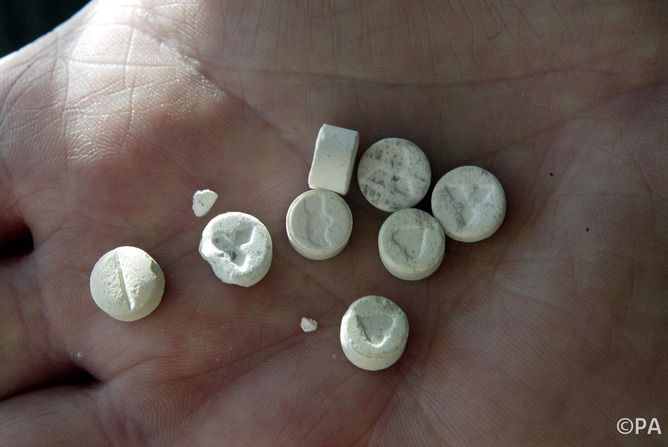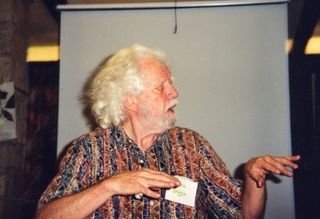Molecules Have No Morals: Ecstasy Godfather Alexander Shulgin's Legacy (Op-Ed)

This article was originally published at The Conversation. The publication contributed the article to Live Science's Expert Voices: Op-Ed & Insights.
The first time ecstasy impinged on the public consciousness in Britain was in November 1995, when an 18-year old Essex schoolgirl named Leah Betts died a few days after taking a tablet at a birthday party. The cause of her death was drinking seven litres of water in 90 minutes, resulting in brain damage – drinking plenty of water was recommended to combat dehydration at rave parties – but ecstasy was widely blamed.
On June 2, the godfather of ecstasy, Alexander Shulgin died. Often called “Sasha”, his name is inextricably linked to the drug. The chemical technically abbreviated as MDMA (3,4-methylenedioxy-N-methylamphetamine) exploded onto the popular musical scene during the 1980s, first in the US, then moving to Europe, originally associated with dance clubs in Ibiza.
But Shulgin deserves to be remembered for more than this one chemical. He trained as a chemist and obtained a PhD in biochemistry at the University of California, Berkeley. He had a successful research career, working for Dow Chemicals as a synthetic chemist, when he created Zectran, the first biodegradeable pesticide, and a very profitable one. In his spare time, Shulgin began to investigate psychoactive molecules, a pursuit influenced by his sampling mescaline.
Maker of highs
What mescaline and ecstasy have in common is what chemists would recognise as a phenylethylamine backbone, a feature shared with Zectran. Phenylethylamine is a molecule containing a hexagonal ring of carbons – a “benzene ring” – to which is attached a side chain containing two more carbon atoms and also bearing an amine group (a nitrogen attached to two hydrogen atoms). It occurs in nature – including the human body – in small amounts. It is a stimulant within the body, though it is rapidly broken down by the liver, so it doesn’t hang around for long.
Once synthetic chemistry started to develop from the late 19th century, chemists started to make molecules with the same core as phenylethylamine but with additional groups – a carbon added here, or a chain of a couple of carbons there. Amphetamine was first made in 1887, and methamphetamine, ecstasy and many more followed close at its heels. These molecules do not occur in nature, so our body doesn’t know how to break them down, so they have more pronounced stimulant effects. Amphetamine started to be used as a decongestant and anti-asthmatic medicine in the late 1920s and people soon discovered its potential for abuse.
While he was still working for Dow – they parted company in 1966 – Shulgin was already testing different molecules for their psychoactive properties. He obtained a licence from the US Drug Enforcement Agency for a laboratory at home and went on to prepare hundreds of variants on the amphetamine unit. He tested them on himself and a few willing friends, noting down the effect of each dose, whether pleasant or not. Very small changes in the molecular structure can produce dramatic changes in the effect of the molecule within the human body. Although Shulgin did not discover ecstasy – that was done by the pharmaceutical giant Merck in 1912 – he pioneered the exploration of its mind-altering properties.
Sign up for the Live Science daily newsletter now
Get the world’s most fascinating discoveries delivered straight to your inbox.

Bad medicine?
In 1991 Shulgin, along with his wife Ann, published a remarkable book, with an equally remarkable title, PIHKAL, short for Phenylethylamines I Have Known And Loved. The first part of it is semi-autobiographical, describing two characters – Dr Alexander Borodin, known as “Shura”, and his wife Alice. It is for the reader to surmise how closely these two characters correspond to Sasha and Ann.
In total contrast, the second part of the book consists of the complete synthetic details needed to make MDMA and 178 other substituted phenylethylamines, together with accounts of the effect of varying doses of these substances upon the tester. In his foreword to the book, David Nichols of Purdue University, himself an internationally regarded expert on psychoactive molecules, comments, “there has never been a work like it”, going on to add that following recent legislation, it was possible we might never see another.
The DEA evidently had a love-hate relationship with Shulgin, who had actually synthesised molecules for them and acted as an adviser. This synergistic relationship broke down following the publication of PIHKAL, which the DEA regarded as a cookbook for illicit laboratories, and they busted his lab in 1994.
We need to remember that molecules are morally neutral, it is the use to which they are put that matters. Chemistry is the ultimate creative science, making materials that have never existed before. Chemists like Shulgin and Nichols have constructed new molecules with the aim of creating useful medicinal substances, but those same molecules have been abused by illicit drug manufacturers, whose sole motive has been financial gain and without regard to the lives of those people consuming them.
Shulgin maintained that his work was motivated by a belief that MDMA and other molecules could be useful aids to psychotherapists and in recent years evidence has emerged that MDMA may be useful in the treatment of post-traumatic stress disorder, whether victims of war or sexual assault. MDMA may yet prove to be Alexander Shulgin’s most valuable legacy.
Simon Cotton does not work for, consult to, own shares in or receive funding from any company or organisation that would benefit from this article, and has no relevant affiliations.
This article was originally published on The Conversation. Read the original article. Follow all of the Expert Voices issues and debates — and become part of the discussion — on Facebook, Twitter and Google +. The views expressed are those of the author and do not necessarily reflect the views of the publisher. This version of the article was originally published on Live Science.












